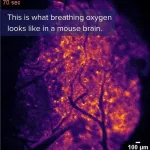(Press-News.org) The human brain consumes vast amounts of energy, which is almost exclusively generated from a form of metabolism that requires oxygen. Consequently, the efficient and timely allocation and delivery of oxygen is critical to healthy brain function, however, the precise mechanics of this process have largely remained hidden from scientists.
A new bioluminescence imaging technique, described today in the journal Science, has created highly detailed, and visually striking, images of the movement of oxygen in the brains of mice.
The method, which can be easily replicated by other labs, will enable researchers to more precisely study forms of hypoxia, such as the denial of oxygen to parts of the brain that occurs during a stroke or heart attack. It is already providing insight into why a sedentary lifestyle increases risk for diseases like Alzheimer’s.
“This research demonstrates that we can monitor changes in oxygen concentration continuously and in a wide area of the brain,” says Maiken Nedergaard, co-director of the Center for Translational Neuromedicine, which is based at both the University of Rochester and the University of Copenhagen.
“This provides us a with a more detailed picture of what is occurring in the brain in real time, allowing us to identify previously undetected areas of temporary hypoxia, which reflect changes in blood flow that can trigger neurological deficits” says Maiken Nedergaard.
Fireflies and serendipitous science
The new method employs luminescent proteins, chemical cousins of the bioluminescent proteins found in fireflies. These proteins, which have been used in cancer research, employ a virus that delivers instructions to cells to produce a luminescent protein in the form of an enzyme. When the enzyme encounters its substrate called furimazine, the chemical reaction generates light.
Like many important scientific discoveries, employing this process to image oxygen in the brain was stumbled upon by accident. Felix Beinlich, Assistant Professor at the Center for Translational Neuroscience at the University of Copenhagen, had originally intended to use luminescent proteins to measure calcium activity in the brain. It became clear there was an error in the protein production, causing a months-long research delay.
While Felix Beinlich waited for a new batch from the manufacturer, he decided to move forward with the experiments to test and optimize the monitoring systems. The virus was used to deliver enzyme-producing instructions to astrocytes, ubiquitous support cells in the brain that maintain the health and signaling functions of neurons, and the substrate was injected directly into the brain.
The recordings revealed activity, identified by a fluctuating intensity of bioluminescence, something that the researchers suspected, and would later confirm, reflected the presence and concentration of oxygen. “The chemical reaction in this instance was oxygen dependent, so when there is the enzyme, the substrate, and oxygen, the system starts to glow,” says Felix Beinlich.
While existing oxygen monitoring techniques provide information about a small area of the brain, the researchers observed, in real time, the entire cortex of the mice. The intensity of the bioluminescence corresponded with the concentration of oxygen, which the researchers demonstrated by changing the amount of oxygen in the air the animals were breathing.
Changes in light intensity also corresponded with sensory processing. For example, when the mice’s whiskers were stimulated with a puff of air, the researchers could see the corresponding sensory region of the brain light up.
“Hypoxic pockets” could point to Alzheimer’s risk
The brain cannot survive long without oxygen, a concept demonstrated by the neurological damage that quickly follows a stroke or heart attack. But what happens when small parts of the brain are denied oxygen for brief periods?
This question was not even being asked by researchers until the team in the Nedergaard lab began to look closely at the new recordings. While monitoring the mice, the researchers observed that specific tiny areas of the brain would intermittently go dark, sometimes for several seconds, meaning that the oxygen supply was cut off.
Oxygen is circulated throughout the brain via a vast network of arteries and smaller capillaries–or microvessels–which permeate brain tissue. Through a series of experiments, the researchers were able to determine that oxygen was being denied due to capillary stalling, which occurs when white blood cells temporarily block microvessels and prevent the passage of oxygen carrying red blood cells.
These areas, which the researchers named “hypoxic pockets,” were more prevalent in the brains of mice during a resting state, compared to when the animals were active. Capillary stalling is believed to increase with age and has been observed in models of Alzheimer’s disease.
“The door is open to study a range of diseases associated with hypoxia in the brain, including Alzheimer’s, vascular dementia, and long COVID, and how a sedentary lifestyle, aging, hypertension, and other factors contribute to these diseases,” says Maiken Nedergaard and adds:
“It also provides a tool to test different drugs and types of exercise that improve vascular health and slow down the road to dementia.”
You can read the study “insert name of study and link here” in Science.
Additional authors include Antonios Asiminas with the University of Copenhagen, Hajime Hirase with the University of Rochester, Verena Untiet, Zuzanna Bojarowska, Virginia Plá, and Björn Sigurdsson with the University of Copenhagen, and Vincenzo Timmel, Lukas Gehrig, and Michael H. Graber with the University of Applied Sciences and Arts Northwestern Switzerland. The study was supported with funding from the National Institute of Neurological Disorders and Stroke, the Dr. Miriam and Sheldon G. Adelson Medical Research Foundation, the Novo Nordisk Foundation, the Lundbeck Foundation, Independent Research Fund Denmark, and the US Army Research Office.
END
New imaging method illuminates oxygen's journey in the brain
Researchers can now observe in real time how oxygen moves around in the brains of mice. This could provide insights into diseases such as Alzheimer's, strokes, and heart attacks
2024-03-28
ELSE PRESS RELEASES FROM THIS DATE:
Researchers discover key gene for toxic alkaloid in barley
2024-03-28
All plants mediate their environmental interactions via chemical signals. An example is the alkaloid gramine produced by barley, one of the world’s most widely grown cereals. Gramine provides protection against herbivorous insects and grazing animals and inhibits the growth of other plants. Despite long-standing interest, the key gene for the formation of gramine remained elusive.
The researchers discovered a cluster of two genes in barley for gramine biosynthesis. The first gene (HvNMT) had already been discovered 18 years ago. In their study the researchers from IPK and the Leibniz University Hannover now identified a second gene (AMI synthase, HvAMIS), and ...
New approach to monitoring freshwater quality can identify sources of pollution, and predict their effects
2024-03-28
The source of pollutants in rivers and freshwater lakes can now be identified using a comprehensive new water quality analysis, according to scientists at the University of Cambridge and Trent University, Canada.
Microparticles from car tyres, pesticides from farmers’ fields, and toxins from harmful algal blooms are just some of the organic chemicals that can be detected using the new approach, which also indicates the impact these chemicals are likely to have in a particular river or lake.
Importantly, the approach can also point to the origin of specific organic matter dissolved in the water, because it has a distinct ...
Bidirectional link between premenstrual disorders and perinatal depression
2024-03-28
Women with premenstrual syndrome (PMS) or premenstrual dysphoric disorder (PMDD) have a higher risk of perinatal depression. Conversely, women with perinatal depression have a higher risk of developing premenstrual disorders. This is shown in a study from Karolinska Institutet published in the journal PLOS Medicine.
Premenstrual disorders like PMS or PMDD and perinatal depression are similar in the way that symptoms appear in connection with hormonal changes. This fact has given rise to the hypothesis ...
Cell division quality control ‘stopwatch’ uncovered
2024-03-28
Each day, hundreds of billions of cells in our body cycle through a period of growth and division. Yet in that time, only about 30 minutes is spent on the critical orchestration of mitosis, when chromosomes are carefully segregated from one parent cell to the next generation of two daughter cells.
It’s during this crucial period of cell division that things can go haywire. Chromosomes can be misdirected, leading to damaged and diseased cells that progress to different types of cancer. University of California San Diego scientists reporting in the journal Science have found a key mechanism that keeps track of mitosis timing and ...
Vaccine protects cattle from bovine tuberculosis, may eliminate disease
2024-03-28
UNIVERSITY PARK, Pa. — Bovine tuberculosis (TB) is a livestock disease that results in large economic losses to animal agriculture worldwide. The disease can also transmit to humans and cause severe illness and death. Researchers from Penn State, Addis Ababa University and the University of Cambridge have now demonstrated that a vaccine for TB currently used in humans significantly reduces infectiousness of vaccinated livestock, improving prospects for elimination and control. The study published today (March 28) in the journal Science.
The spillover ...
Andrew Siemion to receive the SETI Institute’s 2024 Drake Award
2024-03-28
March 28, 2024, Mountain View, CA -- The SETI Institute is pleased to announce that Dr. Andrew Siemion will be honored with the prestigious 2024 Drake Award for his exceptional and pioneering contributions to SETI and radio astronomy and his leadership in the field. Siemion's distinguished career includes his role as the Bernard M. Oliver Chair for SETI at the SETI Institute, Principal Investigator for the Breakthrough Listen Initiative at the University of Oxford, along with holding an Honorary Professorship ...
New study shows how the Crimean-Congo hemorrhagic fever virus enters our cells
2024-03-28
Researchers at Karolinska Institutet, in collaboration with JLP Health and others, have identified how the tick-borne Crimean-Congo haemorrhagic fever virus enters our cells. The results are published in Nature Microbiology and are an important step in the development of drugs against the deadly disease.
Crimean-Congo haemorrhagic fever virus (CCHF virus) is spread through tick bites and can cause haemorrhagic fever. The disease is serious and has a mortality rate of up to 40 per cent depending on the health status of the person infected. Common symptoms ...
Neoadjuvant chemotherapy proves effective for locally advanced penile squamous cell carcinoma
2024-03-28
In a recent multi-center study published in the Journal of the National Cancer Institute, researchers examined the effects of neoadjuvant chemotherapy (NAC) on patients suffering from locally advanced penile squamous cell carcinoma (PSCC). Dr. Kyle Rose, urologic oncologist at Ochsner MD Anderson Cancer Center, was the lead author for the publication.
The research included a cohort of 209 patients undergoing NAC, targeting locally advanced and clinically node positive PSCC. The patient group showed a diverse range of disease severity, with a distribution including 7% with stage II, 48% with stage III, and 45% with stage IV PSCC, ...
Study flips treatment paradigm in bilateral Wilms tumor, shows resistance to chemotherapy may point toward favorable outcomes
2024-03-28
(MEMPHIS, Tenn. – March 28, 2024) Resistance to chemotherapy is typically associated with poor outcomes for patients with cancer. However, St. Jude Children’s Research Hospital scientists demonstrated that in bilateral Wilms tumor (cancer in both kidneys) chemotherapy resistance can point toward a more favorable histology and an ultimatelygood outcome. The study revealed that tumors that do not respond to neoadjuvant, or tumor-shrinking, chemotherapy are predominantly ...
Doctors received approximately $12.1 billion from drug and device makers between 2013-2022
2024-03-28
HERSHEY, Pa. — Despite evidence that financial conflicts of interest may influence medical practice and research and may erode patient trust in medical professionals, these relationships remain pervasive. According to a new analysis of the Open Payments platform, a database that tracks payments between physicians and industry, a team led by a Penn State researcher found that doctors received approximately $12.1 billion from drug and device makers between 2013 and 2022.
Their findings published today (March 28) in JAMA. It’s one of the first studies to look at industry payments longitudinally and by specialty.
“Overall, ...
LAST 30 PRESS RELEASES:
For teens, any cannabis use may have impact on emotional health, academic performance
School meals could unlock major gains for human and planetary health
Menopause hormone therapy does not appear to impact dementia risk
Signature patterns of brain activity may help predict recovery from traumatic brain injury
Dresden study uncovers new key mechanism in cancer cells
New species are now being discovered faster than ever before, study suggests
Cannabis-based products show limited short-term benefit for chronic pain, with increased risk of adverse effects
Cannabis products with more THC slightly reduce pain but cause more side effects
Clearing the brain of aging cells could aid epilepsy and reduce seizures
Brain injuries linked with potential risk of suicide, new study finds
New technique lights up where drugs go in the body, cell by cell
New study finds movement of fishing fleets can reveal shifts in marine ecosystems
Embargoed: New evidence points to potential treatment for vascular dementia
Study uncovers disrupted brain balance in alcohol dependence
Working in groups can help Republicans and Democrats agree on controversial content moderation online
Structural findings reveal how distinct GPCR ligands create different levels of activation
Anything-goes “anyons” may be at the root of surprising quantum experiments
UC review: Maximizing workplace opportunity for veterans
From generation to complex control: Metasurfaces make perfect vortex beams "within reach"
Thin-film lithium niobate-based detector: recent advances and perspectives
Exploring why some people may tend to persistently make bad choices
How cells balance their protein levels
Nirsevimab vs RSVpreF vaccine for RSV–related hospitalization in newborns
Effectiveness and impact of maternal RSV immunization and nirsevimab on medically attended RSV in US children
AI gives scientists a boost, but at the cost of too many mediocre papers
Next-generation vision model maps tree growth at sub-meter precision
Genes aren’t destiny for inherited blindness, study shows
MIT study: High-fat diets make liver cells more likely to become cancerous
Exposure to multiple fine particulate matter components and incident depression in the US Medicare population
Risk of burdensome health care spending over time in the US
[Press-News.org] New imaging method illuminates oxygen's journey in the brainResearchers can now observe in real time how oxygen moves around in the brains of mice. This could provide insights into diseases such as Alzheimer's, strokes, and heart attacks







